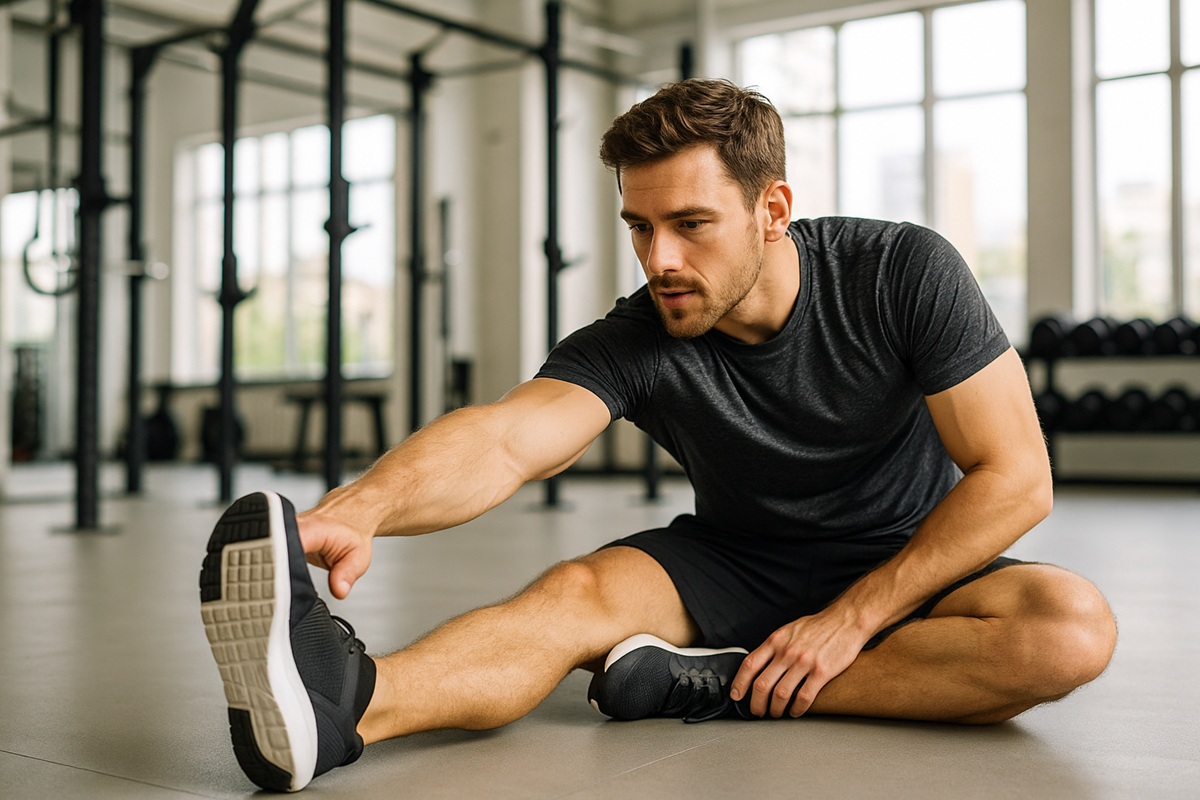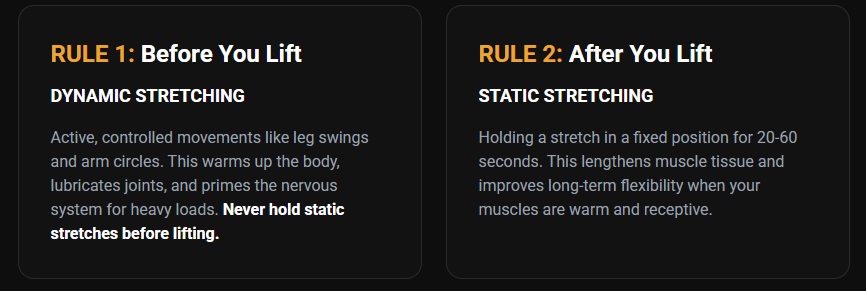Stretching for Bodybuilders - Stronger, Safer, More Mobile

If you think stretching is just for yogis and gymnasts, you're leaving muscle growth, strength, and recovery on the table. For bodybuilders, a tight muscle is a weak muscle—one that limits your range of motion in a deep squat and cheats you out of a full contraction on a chest press. This guide isn't about becoming contortionists. It’s about using targeted stretching to build a more powerful, resilient, and impressive physique.
Why Smart Bodybuilders Stretch: The Anabolic Advantage

Mobility is the silent partner to hypertrophy. When your muscles and the surrounding fascia are pliable, you unlock significant performance and growth benefits. Here's how a dedicated bodybuilding stretching routine directly fuels your progress:
- Enhanced Range of Motion (ROM): deeper squats, fuller chest flyes, and a greater stretch on RDLs all create more mechanical tension—the primary driver of muscle growth.
- Improved Injury Resilience: flexible muscles and tendons distribute force more evenly, reducing the strain on joints and lowering your risk of nagging tweaks that derail training consistency.
- Accelerated Recovery: post-workout static stretching can help reduce neuromuscular excitability, calm the nervous system, and increase blood flow, delivering vital nutrients for repair.
- Better Mind-Muscle Connection: some evidence suggests that "loaded stretching" or fascial stretching can increase the potential space for a muscle to grow, leading to fuller pumps and a more pronounced aesthetic.
The 2 Golden Rules of Stretching for Strength

Timing is everything. Using the wrong type of stretch at the wrong time can temporarily reduce power output. Follow these two simple rules to maximize benefits and minimize risk.
Rule 1: Dynamic Stretching Before You Lift
What it is: active, controlled movements that take your joints through their full range of motion (e.g., leg swings, arm circles). This serves as a warm-up, increasing core temperature, lubricating joints, and priming the nervous system for heavy loads. Never perform long, static holds before lifting.
Rule 2: Static Stretching After You Lift
What it is: holding a stretch in a fixed position for an extended period (20-60 seconds). This is where you lengthen muscle tissue and improve long-term flexibility. Your muscles are warm and most receptive to change after your workout is complete.
The Essential Bodybuilder's Stretching Library
These are the non-negotiable stretches every serious lifter should master. Focus on feeling a deep pull in the muscle belly, not a sharp pain in the joint.
Chest & Anterior Delts
Doorway Pec Stretch: crucial for posture and enabling a full pec contraction. Place your forearm on a doorframe, elbow at or just below shoulder height, and gently step through. Hold for 30-45 seconds per side.
Lats & Upper Back
Passive Dead Hang: decompresses the spine and provides an unparalleled lat stretch. Simply hang from a pull-up bar, relax your shoulders, and breathe. Hold for 30-60 seconds.
Shoulders (Posterior & Medial)
Cross-Body Shoulder Stretch: targets the rear and side delts, which often get tight from heavy pressing. Gently pull one arm across your chest, ensuring you don't let your shoulder shrug up. Hold for 20-30 seconds per side.
Hips & Glutes
Kneeling Hip Flexor Stretch: the antidote to sitting. Tight hip flexors inhibit glute activation and limit squat depth. In a lunge position, posteriorly tilt your pelvis (tuck your tailbone) before shifting your weight forward. Hold for 30-45 seconds per side.
Figure-4 Glute Stretch: Essential for hip health and unlocking power for squats and deadlifts. Lie on your back, cross one ankle over the opposite knee, and pull the thigh toward you. Hold for 30-45 seconds per side.
Hamstrings & Calves
Standing or Seated Hamstring Fold: a must for deadlift performance and lower back health. Hinge at your hips, keeping your spine long, until you feel a deep stretch in your hamstrings. Hold for 30-60 seconds.
Wall Calf Stretch: target both calf muscles. First, with a straight leg, press your heel into the floor (stretches the gastrocnemius). Then, bend the knee slightly to target the deeper soleus muscle. Hold each position for 20-30 seconds per side.
Your 10-Minute Post-Workout Stretching Protocol
Perform this routine immediately after your training session. For best results, pair the stretches with the muscle groups you just trained (e.g., prioritize chest and lat stretches after an upper-body day).
| Body Area | Exercise | Time | Notes |
|---|---|---|---|
| Chest | Doorway Chest Stretch | 2 x 20–30s/side | Keep ribs stacked; feel pec, not shoulder joint. |
| Shoulders | Cross-Body Shoulder Stretch | 1–2 x 20–30s/side | Relax the trap; gentle pull only. |
| Lats | Hanging Lat Stretch | 1–2 x 20–40s | Light passive hang; avoid excessive arching. |
| Hip Flexors | Kneeling Hip Flexor Stretch | 2 x 20–30s/side | Posterior pelvic tilt first, then shift forward. |
| Quads | Standing Quad Stretch | 1–2 x 20–30s/side | Knees together, torso tall. |
| Hamstrings | Seated Hamstring Fold | 1–2 x 20–40s | Hinge at hips; long spine. |
| Glutes | Figure-4 Glute Stretch | 1–2 x 20–40s/side | Keep low back neutral. |
| Calves | Wall Calf Stretch (straight + bent knee) | 1 x 20–30s/side each | Hit both gastroc and soleus. |
Short on time? Rotate focus by choosing 3–4 priority areas after each session and cycle through the rest across the week.
Frequently Asked Questions (FAQ)
Do bodybuilders need to stretch?
Yes. Stretching improves range of motion, supports recovery, and helps prevent injuries. Most professional bodybuilders include flexibility work in their routine to stay mobile and perform lifts with better form.
Is stretching good for muscle growth?
Indirectly, yes. Stretching improves muscle activation and allows deeper contractions during lifts. Post-workout static stretching can also help reduce tension and support better recovery between sessions.
Does stretching after lifting reduce gains?
No. Stretching after lifting does not harm muscle growth. It can actually help reduce stiffness and improve blood flow. Just avoid long static stretches before heavy training — they can temporarily reduce power output.
Can bodybuilders be flexible?
Absolutely. Many top bodybuilders work on flexibility to improve posing, reduce joint pain, and keep muscles balanced. Flexibility helps them train harder and look more symmetrical on stage.
How long should you stretch per day?
10–15 minutes is enough for most people. Focus on the muscle groups you trained that day. Consistency matters more than duration — even short daily sessions make a big difference over time.
Is 20 minutes of stretching enough?
Yes, that’s plenty. A focused 20-minute session covering major areas (hips, chest, shoulders, hamstrings) will improve flexibility and recovery without cutting into your main workout.
What happens if I stretch every day?
Daily stretching can increase mobility and reduce soreness. As long as you stay within a comfortable range, it’s safe and beneficial. Avoid forcing stretches — progress should feel gradual, not painful.
Do you need rest days from stretching?
No. Light stretching can be done every day. Your muscles recover faster from gentle mobility work than from strength training, so it doesn’t require rest days.
What are signs of overstretching?
Sharp pain, joint discomfort, or muscle soreness that lasts more than a day are red flags. Stretching should feel like mild tension, not pain. Back off immediately if you feel a pulling or tearing sensation.
Does stretching count as exercise?
Yes, but it’s a low-intensity form of movement. Stretching improves mobility, blood flow, and recovery, but it doesn’t build significant muscle or burn many calories by itself.
What is the most effective way to stretch?
Warm up first, then stretch after training while muscles are still warm. Hold each position for 20–40 seconds and breathe deeply. Focus on control, not force — consistency is more important than intensity.
What type of stretching is not recommended?
Bouncing or jerky movements (ballistic stretching) can cause microtears and reduce stability. Always stretch slowly and steadily to avoid injury.
What type of stretching is best for seniors?
Gentle static and dynamic stretches are best. Focus on joint mobility and balance rather than deep flexibility. Light resistance bands can also help maintain strength safely.
What should you avoid while stretching?
Don’t hold your breath, bounce, or push past pain. Stretching should relieve tension, not create it. Maintain good posture and move smoothly through each position.
Can you build muscle just by stretching?
No. Stretching alone doesn’t provide enough mechanical tension to build muscle. However, it supports lifting performance, which leads to better muscle growth over time.
How long should you hold a stretch?
Hold each stretch for 20–60 seconds, depending on the area and your flexibility level. Shorter holds warm up the muscles; longer holds after training help improve long-term flexibility.
The Takeaway: Stretch for Strength

Stop viewing stretching as an optional add-on and start seeing it as a critical tool for unlocking your true potential. A consistent 10-minute investment after each workout will pay massive dividends in your performance, physique, and longevity in the iron game. Bookmark this routine and make it a non-negotiable part of your training.
Next Steps
Save this page and follow the routine for 4–6 weeks. Track how your squat depth, bench setup, and overhead positions feel over time. Want a full 4-week training plan that blends mobility, hypertrophy, and progressive overload? Try our personalized generator for just $5.
Useful tools:
• One-Rep Max (1RM) Calculator
• Macro Calculator